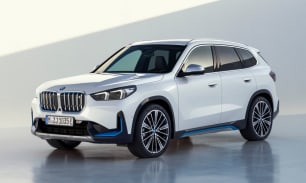One of the best things about the iX1 xDrive30 is that it has just enough EV smoothness, refinement and speed to feel special, yet still drives and behaves as a BMW should.
Which hasn't always been the case with previous-gen X1s.
It helps that, from the driver’s seat, everything falls into place: the bracing seats, thoughtfully positioned relative to all controls; and the overall sporty/quality ambience that puts you into the brand mindset.
Select Drive, and the iX1 leaps away sweetly and silently, accompanied by an electric motor whir that's quite pleasing. At speed, acceleration is instant for fast overtaking and there’s plenty more in reserve if you really need to hustle along.
For a 2.0-tonne compact SUV, the steering is remarkably responsive, providing nimble yet secure handling. Maybe it’s all the low-slung weight and near-50:50 weight distribution, but the iX1 displays impressive cornering and road grip. It’s an enjoyable drive.
Initially, novices might find the brakes a bit sudden, but they’re actually pretty progressive once you get used to them, and they feel and stop with a more natural pedal feel than many hybrids we’ve experienced. Again, BMW has tuned the xDrive30 to feel inclusive.
Speaking of the stoppers, there are no paddle shifters to control the amount of single-pedal off-accelerator braking as per many other EVs, but putting the transmission from ‘D’ to ‘B’ brings a decent level of deceleration if not a full stop – as if you’re lighting resting your foot on the pedal. We’d like the option of a heavier self-braking function, though.
The launch program avoided city roads and heavy traffic, but we still found plenty of bad, pot-holed surfaces to favourably judge the adaptive dampers’ ability to help soak up the bumps.
While not super-soft or supple, the suspension is cushy enough for a comfy ride. And certainly better than many past BMW SUVs.
A bit too much road and tyre noise intrusion aside, the xDrive30 is dynamically very sorted indeed.
Which, when you consider all the other positive aspects of the iX1, you end up with a BMW offering an impressively broad band of capabilities.
It’s rapid, nimble and reactive to driver inputs, as you’d expect an SUV from this brand to be, without the compromise of harshness or discomfort.
What it’s like around town in a peak-hour crawl, or how far you can really get from a fully-charged battery, is something we’ll find out when we can conduct a full road test, so please watch this space.
Until then, as it stands, things are looking promising indeed for the xDrive30. Especially factoring in the value pricing.







